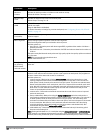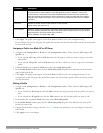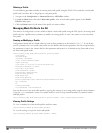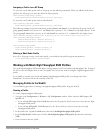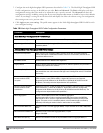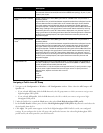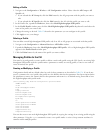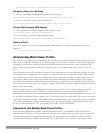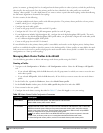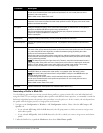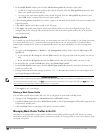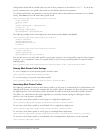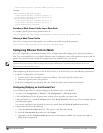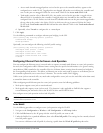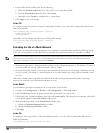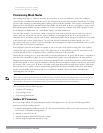
460 | SecureEnterpriseMesh DellPowerConnectW-SeriesArubaOS6.2 | User Guide
points, in contrast, go through the list of configured mesh cluster profiles in order of priority to find the profile being
advertised by the mesh portal. Once the primary profile has been identified, the other profiles are considered
“backup” cluster profiles. Use this deployment if you want to enforce a particular mesh topology rather than allowing
the link metric algorithm to determine the topology.
For this scenario, do the following:
l Configure multiple mesh cluster profiles with different priorities. The primary cluster profile has a lower priority
number, which gives it a higher priority.
l Configure the mesh radio profile.
l Create an AP group for 802.11a radios and 802.11g radios
l Configure the 802.11a or 802.11g RF management profiles for each AP group.
l If your deployment includes high-throughput APs, configure the mesh high-throughput SSID profile. The mesh
radio profile uses the default high-throughput SSID profile unless you specifically configure the mesh radio profile
to use a different high-throughput SSID profile
l Create an AP group for each 802.11a channel.
If a mesh link breaks or the primary cluster profile is unavailable, mesh nodes use the highest priority backup cluster
profile to re-establish the uplink or check for parents in the backup profiles. If these profiles are unavailable, the mesh
node can revert to the recovery profile to bring up the mesh network until a cluster profile is available. For a sample
configuration, see “show ap mesh topology”.
Managing Mesh Cluster Profiles In the WebUI
Use the following procedures to define and manage mesh cluster profiles using the WebUI.
Creating a Profile
1. Navigate to the Configuration > Wireless > AP Configuration window. Select the AP Group or AP Specific
tab.
l If you selected AP Group, click the Edit button by the AP group name for which you want to create the new
mesh cluster profile.
l If you selected AP Specific, click the Edit button by AP for which you want to create the new mesh cluster
profile.
2. In the Profiles list, expand the Meshmenu, then select Mesh Cluster profile.
3. In the Profile Details window pane, click the Add a profile drop-down list and select NEW.
4. Enter a name for the new profile.
5. Configure the mesh cluster settings described in Table 137, then click Apply to save your settings.
Parameter Description
Profile Name Name of the mesh cluster profile. The name must be 1–63 characters.
Default: Mesh cluster profile named “default.”
Cluster Name Indicates the mesh cluster name. The name can have a maximum of 32 characters, and is used as the
MSSID for the mesh cluster. When you first create a new mesh cluster profile, the profile uses the
default cluster name “Dell-mesh”. Use the Cluster Name parameter to define a new, unique MSSID
before you assign APs or AP groups to the mesh cluster profile.
NOTE: If you want a mesh cluster to use WPA2-PSK-AES encryption, do not use spaces in the mesh
cluster name, as this may cause errors in mesh points associated with that mesh cluster.
To view existing mesh cluster profiles, use the CLI command: show ap mesh-cluster-profile.
Table 137:
Mesh Cluster Profile Configuration Parameters



